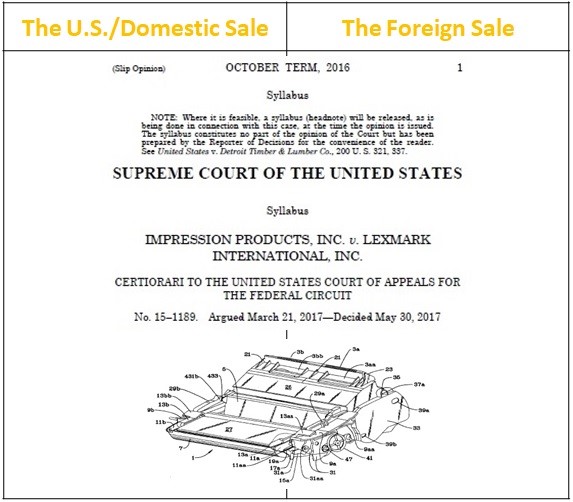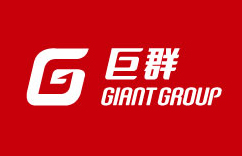【智財評析】「專利權耗盡原則」(Patent Exhaustion Doctrine)的適用將被放寬:美國聯邦最高法院Impression Products v. Lexmark案評析
2019-11-28 陳志清 律師/專利師 (資格)
「專利權耗盡原則」(Patent Exhaustion Doctrine)的適用將被放寬:美國聯邦最高法院Impression Products v. Lexmark案評析
陳志清 律師/專利師(資格)

【重要美國專利案例評析】
美國聯邦最高法院於2017年5月30日,於Impression Products, Inc. v. Lexmark International, Inc. 一案[附註1]中做出了重要判決,改變了之前下級法院的見解,針對「專利權耗盡原則」(Patent Exhaustion Doctrine)的適用,無論是在美國境內的銷售行為(the U.S. sale/the domestic sale)、或是於境外的銷售行為(the foreign sale),其適用上都將被放寬,大大地改變了Impression Products案判決前的觀點,於實務上會造成非常大的影響,頗值得大家注意!
案件背景事實
1. 本案的原告為Lexmark International, Inc.(以下簡稱為”Lexmark”),是一間噴墨印表機及雷射印表機的製造大廠,也販售其相關的墨水匣及碳粉匣(toner cartridge)耗材等。Lexmark在全球銷售兩類型與自家雷射印表機所搭配的碳粉匣,其中,(1) 比較貴的一類,是依照原價格銷售而沒有任何相關限制的「一般碳粉匣」,以及(2) 另一類是有打大約八折、售價比較便宜的,但卻有「單次使用/不可轉賣」(single use/ no-resale restrictions)之合約限制條件的「回收專案碳粉匣」(Return Program cartridges),且只能讓原廠Lexmark進行回收(to use it only once and to refrain from transferring the empty cartridge to anyone but Lexmark)。然而,前述的合約限制條件係僅能與初始購買者簽訂,無法及於更下游的購買者,例如「再製造廠商」。另外,由於該些碳粉匣還內建有一特殊的微晶片(microchip),其他人就算於碳粉使用完畢後自己再行填充入碳粉,該再製造的碳粉匣也不能被再度使用。
2. 而本案的眾多被告之一為Impression Products, Inc.(以下簡稱為”Impression Products”),其為一間「再製造廠商」(remanufacturer),主要從事回收市面上使用過的碳粉匣經過重整(refurbished),包括再度填充碳粉後、再販售給消費者的生意。其中,被告Impression Products即回收了原告Lexmark於美國境內、或是境外所販售的上述兩類型之使用完的碳粉匣,並且想辦法破解這些碳粉匣的內建特殊微晶片,再將碳粉填充入這些碳粉匣中,然後再次轉賣給消費者使用,亦即包括:acquire、refill、再resell的行為。
3. 關於本案涉訟的侵權產品可區分為兩個類型,(1) 原告Lexmark於美國境內銷售的「回收專案碳粉匣」,因為原告Lexmark聲稱其已經於該「回收專案碳粉匣」上明確做出了禁止再使用及再銷售的限制條件,故被告Impression Products的行為侵害其專利權;以及(2) 原告Lexmark於美國境外銷售的「一般碳粉匣」與「回收專案碳粉匣」,被告將這些碳粉匣重整後輸入美國境內販售,原告Lexmark聲稱其並未授權給任何人有權利進口這些碳粉匣進入美國境內,故被告Impression Products的這個行為亦侵害其專利權。
4. 原告Lexmark基於前述理由於俄亥俄州南區聯邦地方法院對被告Impression Products提起專利侵權訴訟,而所主張的相關專利之技術細節並非此次的重點,故略過不提。被告Impression Products針對這兩種類型的侵權產品分別向法院提出了二個「撤銷案件的動議」(motion to dismiss),於2014年,聯邦地方法院分別作出了二個針對美國境內銷售的判決(Domestic Sale Opinion)、以及針對境外銷售的判決(Foreign Sale Opinion),其中,(1) 法院同意撤銷美國境內銷售的部分,但(2) 法院不同意撤銷境外銷售的部分。因此,雙方都不服,皆提起上訴。
5. 於2016年2月12日,聯邦巡迴上訴法院直接經由全院庭審(en banc)作出判決,與地方法院之認定不同,其判決認為:(1) 美國境內銷售部分,專利權並未耗盡,因此專利權人可以依據專利侵權的事由來起訴,(2) 境外銷售部分,專利權亦未耗盡,因此專利權人亦可自由地主張其專利權來控告該廠商。被告Impression Products不服,再度提起上訴,聯邦最高法院稍後同意審理此案。
案件爭點
本案件的主要爭點即在於:究竟原告Lexmark所銷售的碳粉匣,無論是在美國境內的銷售行為、或是於國外的銷售行為,是否會構成專利權耗盡?若是的話,被告Impression Products就可自由地重整後販售、或是從國外購得該些碳粉匣後再進口至美國境內販售(that Lexmark’s sales, both in the United States and abroad, exhausted its patent rights in the cartridges, so Impression Products was free to refurbish and resell them, and to import them if acquired abroad)。
再成兩個部分來細分討論,亦即包含:(1) 專利權人於美國境內的銷售行為,帶有明確的限制購買者再使用或再銷售的權利之條件時,專利權人是否還可以行使其專利權?;以及(2) 專利權人於國外的銷售行為,雖然已經為美國專利法效力所不及,但是否仍會構成專利權之耗盡?
相關法律規定
1. 美國專利法第154(a)條賦予了專利權人排他的權利,而第271(a)條則定義了若一行為人「未經專利權人授權」(without authority from the patentee)的侵權行為,將需要負擔專利侵權的責任。
2. 而當專利權人於銷售其產品後,該產品之所有權因此而移轉給購買者,而成為購買者的私有、個人財產,也因此,該銷售將終止專利權人對該產品所擁有的專利權範圍。這是從1853年的Bloomer案以來,由聯邦最高法院所揭櫫的「專利權耗盡原則」(the doctrine of patent exhaust)之內涵,對專利排他權所作出的限制。
When a patentee chooses to sell an item, that product “is no longer within the limits of the monopoly” and instead becomes the “private, individual property” of the purchaser, with the rights and benefits that come along with ownership. [Bloomer v. McQuewan, 14 How. 539, 549-550 (1853)]. A patentee is free to set the price and negotiate contracts with purchasers, but may not, “by virtue of his patent, control the use or disposition” of the product after ownership passes to the purchaser. United States v. Univis Lens Co., 316 U. S. 241, 250, 62 S.Ct. 1088, 86 L.Ed. 1408 (1942) (emphasis added). The sale “terminates all patent rights to that item.” Quanta Computer, Inc. v. LG Electronics, Inc., 553 U. S. 617, 625, 128 S.Ct. 2109, 170 L.Ed.2d 996 (2008).
Impression Products, Inc. v. Lexmark Int’l, Inc., 137 S. Ct. 1523, 1531 (2017).
聯邦最高法院見解
1. 先講本案的結論,(1) 關於在美國境內的銷售行為部分,美國聯邦最高法院之法官以8:0的結果認為:原告Lexmark在美國境內所銷售的「回收專案碳粉匣」,其專利權已經耗盡,無論專利權人於該銷售時對其加諸了多少限制條件皆然;(2) 而關於在境外的銷售行為部分,美國聯邦最高法院之法官以7:1的結果認為:原告Lexmark於境外所「授權銷售」(authorized sale)的所有碳粉匣,亦如同其在美國境內所銷售的碳粉匣一般,其專利權已經耗盡。
2. 專利權人於美國境內的銷售行為,帶有明確的限制購買者再使用或再銷售的權利之條件時,專利權人是否還可以行使其專利權?
(1) 若一專利權人於其產品進行銷售時,對該產品做出了任何限制、或保留任何權利,那都是專利權人與購買者之間的「合約問題」,並不是專利侵權問題。
Lexmark cannot bring a patent infringement suit against Impression Products to enforce the single-use/ no-resale provision accompanying its Return Program cartridges. Once sold, the Return Program cartridges passed outside of the patent monopoly, and whatever rights Lexmark retained are a matter of the contracts with its purchasers, not the patent law.
Impression Products, Inc. v. Lexmark Int’l, Inc., 137 S. Ct. 1523, 1533 (2017).
(2) 討論關於「銷售」(sale)與「授權」(license)之差異。「銷售」是將該產品的所有權進行移轉,因此,專利權就會隨之耗盡;而「授權」則是關於改變專利權人壟斷範圍的輪廓,因此,專利權人可以自由地放棄對其部分的專利權之主張,亦即可以自由地對其專利權之授權內容加以設限。
但這種專利權人可以對授權內容設限的權利,並不代表專利權人可以對購買者利用授權而來施加售後行為之限制,藉以主張其專利權。
A patentee can impose restrictions on licensees because a license does not implicate the same concerns about restraints on alienation as a sale. Patent exhaustion reflects the principle that, when an item passes into commerce, it should not be shaded by a legal cloud on title as it moves through the marketplace. But a license is not about passing title to a product, it is about changing the contours of the patentee’s monopoly: The patentee agrees not to exclude a licensee from making or selling the patented invention, expanding the club of authorized producers and sellers. See General Elec. Co., 272 U.S., at 489–490, 47 S.Ct. 192. Because the patentee is exchanging rights, not goods, it is free to relinquish only a portion of its bundle of patent protections.
A patentee’s authority to limit licensees does not, as the Federal Circuit thought, mean that patentees can use licenses to impose post-sale restrictions on purchasers that are enforceable through the patent laws.
Impression Products, Inc. v. Lexmark Int’l, Inc., 137 S. Ct. 1523, 1534-1535 (2017).
(3) 只要被授權人在銷售其產品時遵循了授權合約之規定,被授權人的該銷售行為就等同於專利權人自己進行銷售產品一般,一樣會讓其專利權耗盡。
So long as a licensee complies with the license when selling an item, the patentee has, in effect, authorized the sale. That licensee’s sale is treated, for purposes of patent exhaustion, as if the patentee made the sale itself. The result: The sale exhausts the patentee’s rights in that item. See Hobbie v. Jennison, 149 U.S. 355, 362–363, 13 S.Ct. 879, 37 L.Ed. 766 (1893).
Impression Products, Inc. v. Lexmark Int’l, Inc., 137 S. Ct. 1523, 1535 (2017).
(4) 若被授權人銷售其產品的行為落在授權的範圍之外,那麼專利權人就沒有授權該銷售,因此,專利權並沒有耗盡。
General Talking Pictures involved a fundamentally different situation: There, a licensee “knowingly ma[de] . . . sales . . . outside the scope of its license.” 304 U.S., at 181–182, 58 S.Ct. 849 (emphasis added). We treated the sale “as if no license whatsoever had been granted” by the patentee, which meant that the patentee could sue both the licensee and the purchaser — who knew about the breach — for infringement. General Talking Pictures Corp. v. Western Elec. Co., 305 U.S. 124, 127, 59 S.Ct. 116, 83 L.Ed. 81 (1938). . . . General Talking Pictures, then, stands for the modest principle that, if a patentee has not given authority for a licensee to make a sale, that sale cannot exhaust the patentee’s rights.
Impression Products, Inc. v. Lexmark Int’l, Inc., 137 S. Ct. 1523, 1535 (2017).
(5) 總之,一旦專利權人決定要進行產品銷售,無論是透過自己或是透過被授權人來進行銷售,並且無論該專利權人是否有直接或是經由被授權人來施加任何的售後限制,該銷售行為皆會使其專利權耗盡。
In sum, patent exhaustion is uniform and automatic. Once a patentee decides to sell — whether on its own or through a licensee — that sale exhausts its patent rights, regardless of any post-sale restrictions the patentee purports to impose, either directly or through a license.
Impression Products, Inc. v. Lexmark Int’l, Inc., 137 S. Ct. 1523, 1535 (2017).
3. 專利權人於國外的銷售行為,雖然已經為美國專利法效力所不及,但是否仍會構成專利權之耗盡?
(1) 專利權人在美國以外的境外銷售其產品時,其專利權一樣會耗盡,原因跟與著作權法相關的2013年之Kirtsaeng判決一樣。
In Kirtsaeng v. John Wiley & Sons, Inc., we held that this “‘first sale’ [rule] applies to copies of a copyrighted work lawfully made [and sold] abroad.” 568 U. S., at 525, 133 S.Ct. 1351. . . .
Applying patent exhaustion to foreign sales is just as straightforward. Patent exhaustion, too, has its roots in the antipathy toward restraints on alienation, see supra, at 1528 – 1533, and nothing in the text or history of the Patent Act shows that Congress intended to confine that borderless common law principle to domestic sales. In fact, Congress has not altered patent exhaustion at all; it remains an unwritten limit on the scope of the patentee’s monopoly.
Impression Products, Inc. v. Lexmark Int’l, Inc., 137 S. Ct. 1523, 1535-1536 (2017).
(2) 「明示地保留權利法則」(express-reservation rule)。這點值得注意,美國政府對於這個案子遞交了法庭之友意見書給聯邦最高法院,其認為若專利權人在美國境外進行產品銷售時,有明白地依據「明示地保留權利法則」來保留其專利權的話,那麼該專利權就應該沒有耗盡。
但這個見解最後並未被聯邦最高法院所接受。因為其所銷售的產品於市場上流通時,若仍然容許專利權像鮣魚一樣吸附在所銷售出之產品上的話,將會違反了「不應對於物權轉讓出作限制之原則」(the principle against restraints on alienation),故其銷售行為最後仍會造成專利權耗盡之結果。
Exhaustion does not arise because of the parties’ expectations about how sales transfer patent rights. More is at stake when it comes to patents than simply the dealings between the parties, which can be addressed through contract law. Instead, exhaustion occurs because, in a sale, the patentee elects to give up title to an item in exchange for payment. Allowing patent rights to stick remora-like to that item as it flows through the market would violate the principle against restraints on alienation. Exhaustion does not depend on whether the patentee receives a premium for selling in the United States, or the type of rights that buyers expect to receive. As a result, restrictions and location are irrelevant; what matters is the patentee’s decision to make a sale.
Impression Products, Inc. v. Lexmark Int’l, Inc., 137 S. Ct. 1523, 1538 (2017).
4. 最後,聯邦最高法院的「RBG:不恐龍大法官」Ginsburg法官針對美國境外的銷售行為是否會構成專利權耗盡這一部分,做出了不同意見書。她認為境外的銷售行為不應該構成專利權的權利耗盡,專利法的案子並不能跟著作權法的案子相提並論,有興趣的讀者可以再閱讀一下其觀點。
小結
1. 本案件聯邦最高法院推翻了聯邦巡迴上訴法院之原判決、並發回由其重新進行審理。至於本案回到聯邦巡迴上訴法院後及其後續判決結果如何,就請有興趣的讀者再自行參閱。
2. 因此,於本Impression Products案之後,改變了之前下級法院的見解,針對「專利權耗盡原則」,無論是在美國境內的銷售行為、或是於境外的銷售行為,其適用上都將被放寬,頗值得讀者注意!
3. 另外,本案判決出現後所衍生出來有幾個面向值得讀者再多做考慮,包括:(1) 注意專利授權條款中的限制,是「對銷售的限制」(專利權仍然會耗盡),還是「對專利授權的限制」(專利權可能未耗盡)、(2) 往後「賣產品卻保留專利權」的條款會沒有用、(3) 重新考慮不同國家的差價策略、以及(4) 重整產品(refurbished product)的商業模式會更活絡,甚至會有新模式出現[附註3],這些都值得企業內部的智權管理者、或是專利工作者透過本判決多做思考而加以注意!
本文章之專業內容,僅為提供資訊參考,非作為法律諮詢之用,亦純屬作者個人之意見,不代表本所或作者任何曾任職過單位之立場。
相關參考資料
附註1. 美國聯邦最高法院:Impression Products, Inc. v. Lexmark Int’l, Inc., 137 S. Ct. 1523 (Supreme Court, May 30, 2017) 案判決原文,網址:https://www.supremecourt.gov/opinions/16pdf/15-1189_ebfj.pdf(最後瀏覽日期:2019年10月24日)。
附註2. Jason Rantanen, “Impression v. Lexmark: Patent Rights Exhausted by Sale, Domestic or Abroad,” May 30, 2107, Patently-O,網址:https://patentlyo.com/patent/2017/05/impression-exhausted-domestic.html(最後瀏覽日期:2019年10月24日)。
附註3. Gavin Liu著,「[非常重要] 美國聯邦最高法院放寬專利耗盡原則的適用:Impression Products, Inc. v. Lexmark Int’l, Inc. (May 30, 2017)」,2017年6月1日,FairSky’s Patent Memo,網址:https://fairsky-patent.blogspot.com/2017/06/impression-products-inc-v-lexmark-intl.html(最後瀏覽日期:2019年10月24日)。
附註4. Gavin Liu著,「CAFC關於專利耗盡的全院庭審判決:Lexmark Int'l, Inc. v. Impression Prods., Inc. (Fed. Cir., February 12, 2016) (en banc)」,2016年2月15日,FairSky’s Patent Memo,網址:https://fairsky-patent.blogspot.com/2016/02/cafclexmark-intl-inc-v-impression-prods.html(最後瀏覽日期:2019年10月24日)。
附註1. 美國聯邦最高法院:Impression Products, Inc. v. Lexmark Int’l, Inc., 137 S. Ct. 1523 (Supreme Court, May 30, 2017) 案判決原文,網址:https://www.supremecourt.gov/opinions/16pdf/15-1189_ebfj.pdf(最後瀏覽日期:2019年10月24日)。
附註2. Jason Rantanen, “Impression v. Lexmark: Patent Rights Exhausted by Sale, Domestic or Abroad,” May 30, 2107, Patently-O,網址:https://patentlyo.com/patent/2017/05/impression-exhausted-domestic.html(最後瀏覽日期:2019年10月24日)。
附註3. Gavin Liu著,「[非常重要] 美國聯邦最高法院放寬專利耗盡原則的適用:Impression Products, Inc. v. Lexmark Int’l, Inc. (May 30, 2017)」,2017年6月1日,FairSky’s Patent Memo,網址:https://fairsky-patent.blogspot.com/2017/06/impression-products-inc-v-lexmark-intl.html(最後瀏覽日期:2019年10月24日)。
附註4. Gavin Liu著,「CAFC關於專利耗盡的全院庭審判決:Lexmark Int'l, Inc. v. Impression Prods., Inc. (Fed. Cir., February 12, 2016) (en banc)」,2016年2月15日,FairSky’s Patent Memo,網址:https://fairsky-patent.blogspot.com/2016/02/cafclexmark-intl-inc-v-impression-prods.html(最後瀏覽日期:2019年10月24日)。
延伸閱讀:
-
2019-10-04
消息來源:


